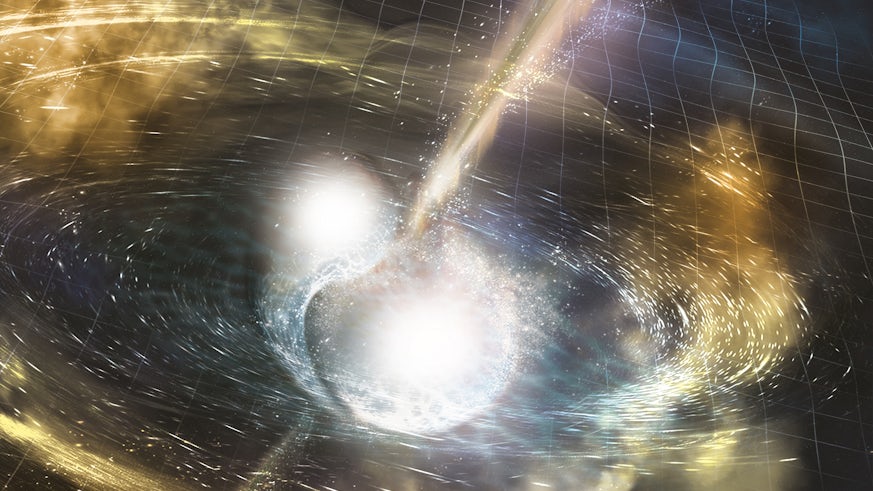First detection of gravitational waves from colliding neutron stars
16 October 2017

Scientists have for the first time directly observed gravitational waves, in addition to light, emitted from the spectacular collision of two neutron stars.
The detection marks the first time that a cosmic event has been viewed in both gravitational waves and light.
The gravitational wave signal, named GW170817, was detected at 1:41pm UK time on 17 August by two identical detectors in Washington and Louisiana and a third detector in Pisa, Italy.
The signal was emitted from the collision of two extremely dense neutron stars about 130 million light-years from Earth. The objects, both 12 miles in diameter, were initially orbiting around 200 miles from each other and had a mass about half a million times that of the Earth.
Neutron stars are the smallest, densest stars known to exist and are formed when massive stars explode in supernovas. These objects are so dense that just a teaspoon of neutron star material would have a mass of about a billion tons.
As the two neutron stars drifted closer together they stretched and distorted space-time giving off energy in the form of powerful gravitational waves – tiny ripples in space-time – before smashing into each other. The gravitational waves were detectable for about 100 seconds.
This landmark discovery was made thanks to the significant contribution of Cardiff University scientists who form part of an international collaboration known as the Laser Interferometer Gravitational-Wave Observatory (LIGO) who operate the detectors in Washington and Louisiana. The discovery was also made with the help of the Europe-based Virgo detector and around 70 ground- and space-based observatories.
Research undertaken at Cardiff University has laid the foundations for how we go about detecting gravitational waves with the development of novel algorithms and software that have now become standard search tools for detecting the elusive signals.
LIGO scientists have detected three gravitational wave signals from colliding black holes to date, as well as a further detection from colliding black holes in collaboration with the Virgo detector.
When the neutron stars collided a flash of light in the form of gamma rays was emitted and seen by satellites orbiting the Earth about two seconds after the gravitational waves. In the days following this spectacular collision, other forms of light such as X-ray, ultraviolet, optical, infrared and radio waves were detected on Earth by dozen of teams of astronomers around the world.
This discovery ushers in a new era of astronomy where gravitational wave networks and traditional light-based astronomy will work hand-in-hand to uncover some of the Universe’s most prized secrets.
Dr Francesco Pannarale, from Cardiff University’s School of Physics and Astronomy, led one of the analyses on this new discovery. He said: “This discovery was everything I always hoped for, packed into a single event. All this rich information came pouring in and we learnt an awful lot.
“My favourite thing is that we confirmed that colliding neutron stars power short gamma-ray bursts, solving one of the greatest mysteries in present day high-energy astrophysics. What is exciting is that we know that we will be able to see similar events to this one in the future, allowing us to learn even more about neutron stars, such as the behaviour of matter in their super-dense cores.”
Professor B S Sathyaprakash, also of the School of Physics and Astronomy, said: “The first discovery of gravitational waves took weeks before we could confirm it; but this event was truly a ‘eureka’ moment. The 12 hours that followed are inarguably the most exciting hours of my scientific life. This event marks a turning point in observational astronomy and will lead to a treasure trove of scientific results.”
One consequence of the detection was that it enabled scientists to use gravitational waves to measure the expansion rate of the Universe, otherwise known as the Hubble constant. This was something that Cardiff University’s Professor Bernard Schutz first predicted would be possible over 30 years ago.
Commenting on the detection, Professor Schutz said: “When the three detectors of the LIGO-Virgo network pointed the direction to the source of this amazingly loud signal, and a small army of partner astronomers quickly told us that there was a new object brightening up the sky and pinpointing the location even more precisely, I knew that we were going to be able for the first time to use gravitational waves to measure the expansion rate of the Universe.
“But what has amazed me even more is that, with just this one measurement, we got a result right in the middle between the two rather different values that astronomers have measured recently. I am looking forward to sharpening up our contribution to measuring this key number once our detectors come back online in a year.”
Share this story
It is a friendly, approachable School with a strong commitment to teaching excellence and world class research in physics and astronomy.




